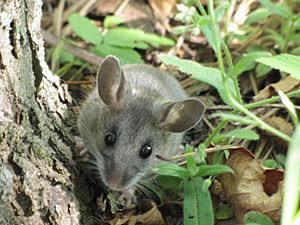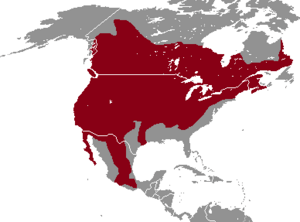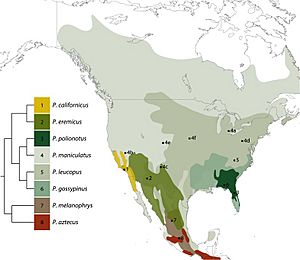Eastern deer mouse facts for kids
Quick facts for kids Eastern deer mouse |
|
|---|---|
 |
|
| In Schoolcraft County, Michigan | |
| Conservation status | |
| Scientific classification | |
| Genus: |
Peromyscus
|
| Species: |
maniculatus
|
The Eastern Deer Mouse (Peromyscus maniculatus) is a small rodent that lives in eastern North America. It is found across most of North America east of the Mississippi River. However, you won't find it in the low-lying areas of the southeastern United States.
Like other mice in the Peromyscus family, the Eastern Deer Mouse can carry germs that cause diseases. These include hantaviruses and Lyme disease. But the mice themselves usually don't get sick from these germs.
This mouse is very similar to the white-footed mouse (Peromyscus leucopus).
Contents
About the Eastern Deer Mouse
The Eastern Deer Mouse is a tiny mammal that is very common. It lives in eastern North America. It looks a lot like the white-footed mouse. Because they look so alike, scientists often need special tests to tell them apart.
You can sometimes tell a deer mouse by its long, two-colored tail. The top of the tail is dark, and the bottom is light. These mice are often used in labs because they are clean and easy to care for.
What the Eastern Deer Mouse Looks Like
The Eastern Deer Mouse is quite small. It is only about 3 to 4 inches (7.5 to 10 cm) long, not counting its tail. They have big, shiny eyes and large ears. This gives them excellent sight and hearing.
Their fur is soft and can be gray or brown. But all deer mice have a white belly and white feet. Their tails are covered with fine hairs and are dark on top and white underneath, just like their bodies.
There are different types of Eastern Deer Mice. For example, the ones that live in forests have longer back legs, a longer tail, and bigger ears than those that live in open fields.
How the Eastern Deer Mouse Behaves
Eastern Deer Mice are night animals. They sleep during the day in places like trees or burrows. They build nests from plant materials. A mother deer mouse keeps her babies in her own special area.
These mice usually live in an area from about 2,600 to 32,000 square feet (242 to 3,000 square meters). While they have their own areas, these areas often overlap. When they overlap, it's usually between a male and a female. Male deer mice have much larger home ranges than females. Females are more protective of their space. Mice that live in overlapping areas often recognize each other and interact a lot.
The forest type of deer mouse is a great climber. It likes to live in trees high above the ground. The field type prefers to move between burrows in open areas, staying away from plants.
Surviving in High Places
Some deer mice live in high mountains. Here, there is less oxygen and it's very cold. They live their whole lives and raise their families in these tough conditions. Living with low oxygen can affect how these mice grow when they are babies.
However, deer mice in high places have special body features that help them survive. They are better at using energy from food like carbohydrates and fats. Their blood also has special changes that help them carry more oxygen. This helps them live in places where oxygen is scarce.
Reproduction and Life Cycle
How They Have Babies
Eastern Deer Mice often have one male mate with several females. Males usually have much larger territories than females. Even though they usually live alone, in winter, a male and several females might share a nest to stay warm.
When They Breed
Deer mice can have babies all year round. But in most places, they breed from March to October. How much food is available often decides when they breed, more than the season itself. In Virginia, for example, they have the most babies from April to June and again from September to October.
Building Nests
Female deer mice build nests using many different things. These include grasses, roots, moss, wool, and even man-made fibers. Male deer mice are sometimes allowed by the female to help care for the babies. They help keep the babies together and warm.
Studies show that less than half of both male and female deer mice leave their first home to have babies. This means that mice from the same family might mate. This limits how much their genes mix with other deer mice groups.
Gestation, Litter Size, and Growth
Deer mice have many babies. They are one of the most common mammals in their areas. A female mouse is pregnant for about 22 to 26 days. A typical litter has three to five babies, but it can be anywhere from one to nine.
Most female deer mice have more than one litter each year. Three or four litters per year is common. Some mice in labs have had as many as 14 litters in one year! Males often stay with the family and help take care of the young.
Baby Mouse Development
Baby deer mice are born helpless. They are blind, naked, and can't do much on their own. But they grow very fast! They get a full coat of fur by the end of their second week. Their eyes open when they are between 13 and 19 days old. They are fully furred and can live on their own in just a few weeks.
Mothers feed their babies milk for about 27 to 34 days. Most young mice stop drinking milk when they are about 18 to 24 days old. They reach adult size at about 6 weeks old. They continue to gain a little weight after that.
Female mice can have babies for the first time when they are about 48 days old on average. The youngest known wild female to have babies was 55 days old. This means she got pregnant when she was only about 32 days old.
Leaving Home
Young deer mice usually leave their birth area after they stop drinking milk. This happens before the next litter is born, when they are becoming old enough to have their own babies. Sometimes, young mice stay in their birth area, especially if there isn't much space to live elsewhere. Most deer mice travel less than 500 feet (152 meters) from where they were born to find their own home.
How Long They Live
In a lab, deer mice can live up to 96 months (8 years). On average, females live about 45.5 months, and males live about 47.5 months in labs. In the wild, many deer mice live less than 1 year. One male deer mouse in a lab lived for 32 months. There's even a report of a forest deer mouse that lived 8 years in captivity! Another mouse was able to have babies until it was almost 6 years old.
Where the Eastern Deer Mouse Lives
Peromyscus maniculatus can be found all over eastern North America. Most deer mice build their nests high up in large, hollow trees. A deer mouse usually nests alone. But in winter, they might nest in groups of 10 or more to stay warm.
The field type of deer mouse is also common in the farmlands of the midwestern United States. In winter, deer mice can be seen active on top of snow or under logs. In northern New England, they live in both pine and leafy forests. Deer mice are often the only Peromyscus species found in northern forests. Different types of deer mice prefer different kinds of plants and places to live. There are two main groups: the prairie (field) deer mouse and the woodland (forest) deer mouse.
Places to Hide
Deer mice are often active in open areas. Most types do not make hidden paths like many voles do. In open areas within forests, deer mice tend to go to the nearest trees for cover. In central Ontario, deer mice use fallen wood as pathways.
Deer mice build nests in burrows they dig in the ground. They also build nests in raised spots like brush piles, logs, rocks, stumps, under tree bark, and in hollow parts of trees. Nests have also been found in old buildings and even abandoned cars. Some nests have been found as high as 80 feet (24 meters) above the ground in Douglas-fir trees.
Who Hunts the Eastern Deer Mouse
Deer mice are an important food source for many animals. These include snakes, owls, American minks, American martens, and other weasel-like animals. Skunks, bobcats, house cats, coyotes, and foxes also hunt them. Deer mice can also be bothered by a type of fly called Cuterebra fontinella, which lays its eggs on them.
What the Eastern Deer Mouse Eats
Deer mice eat many different things. They are omnivorous. Their main foods are seeds, fruits, arthropods (like insects and spiders), leaves, and fungi. Fungi are eaten the least.
Throughout the year, the deer mouse changes what it eats based on what is available. In winter, arthropods make up about one-fifth of their diet. These include spiders, caterpillars, and true bugs. In spring, seeds become available, and they eat many insects. Leaves are also found in their stomachs during spring. In summer, they eat seeds and fruits. In the fall, their diet slowly changes to be more like their winter diet.
See also
 In Spanish: Ratón ciervo para niños
In Spanish: Ratón ciervo para niños




